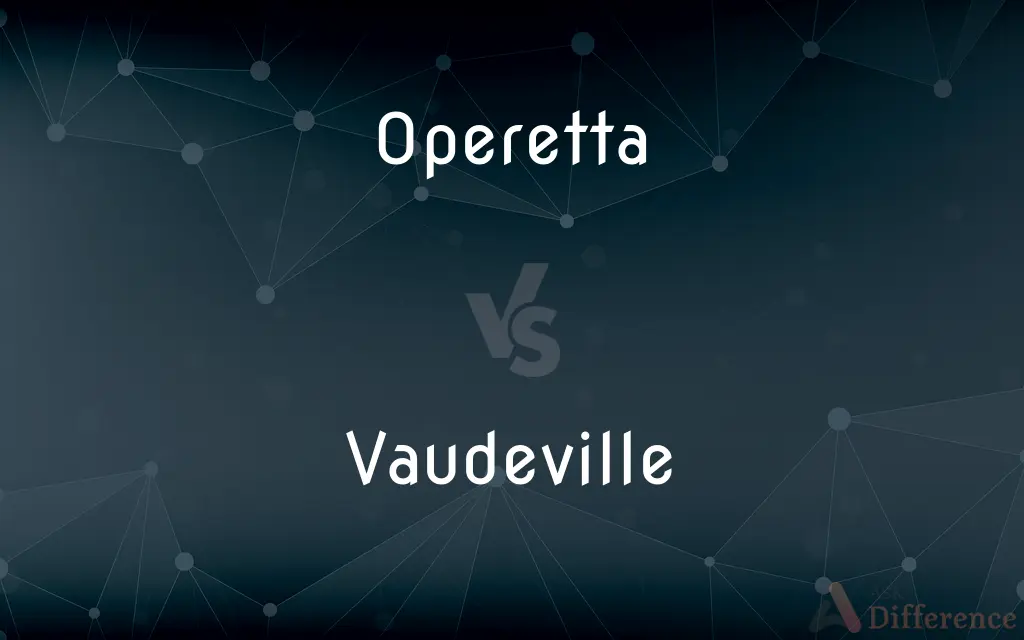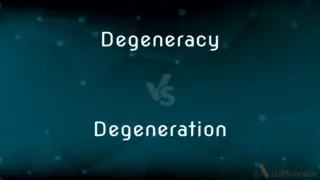Operetta vs. Vaudeville — What's the Difference?
By Maham Liaqat & Urooj Arif — Updated on April 2, 2024
Operetta is a light opera with songs, dialogue, and dancing, focusing on music and story, whereas vaudeville is a variety show featuring diverse acts without a unifying story, emphasizing entertainment variety.

Difference Between Operetta and Vaudeville
Table of Contents
ADVERTISEMENT
Key Differences
Operetta, a genre of light opera, combines music, dialogue, and dance to tell a story, usually characterized by its light-hearted, often romantic plots. It's a theatrical performance where the musical and narrative elements are tightly interwoven. On the other hand, vaudeville is a type of entertainment that was popular especially in the US from the late 19th to the early 20th century, consisting of a series of separate, unrelated acts grouped together on a common bill, including musicians, comedians, and magicians, focusing on variety rather than a continuous storyline.
The musical aspect of operettas is crucial, with songs and orchestral compositions driving the narrative forward and developing characters, while dialogue bridges the musical segments. Vaudeville shows, however, relied on the diversity of acts to entertain, with music being just one of many types of performances, and without the intention of telling a single, coherent story.
Operetta audiences are often drawn to the blend of accessible, melodious music and engaging stories that provide an escape into whimsy and romance. In contrast, vaudeville appealed to a broad spectrum of society by offering a wide range of entertainment options, ensuring that there was something for everyone, regardless of individual tastes.
The production of an operetta involves composers, lyricists, and librettists working together to create a cohesive work where the music and story are interdependent. Vaudeville shows, however, were assembled by booking various acts that could range from acrobatics to comedy sketches, with performers often responsible for their own material and segments.
While operetta can be seen as a precursor to modern musical theatre, with its combination of story and song, vaudeville contributed to the development of variety entertainment, including television variety shows. Both forms have left a lasting impact on the entertainment industry, though in significantly different ways.
ADVERTISEMENT
Comparison Chart
Definition
A light opera with songs, dialogue, and dance.
A variety show with diverse acts.
Key Components
Music, story, dance.
Music, comedy, dance, magic, acrobatics.
Narrative
Unified, continuous storyline.
Series of unrelated acts.
Audience Appeal
Melodious music and engaging stories.
Wide range of entertainment options.
Historical Context
Popular in the 19th and early 20th centuries.
Flourished in late 19th to early 20th century.
Production
Collaborative creation of music and story.
Compilation of diverse acts.
Impact
Precursor to modern musical theatre.
Influenced variety entertainment and TV shows.
Compare with Definitions
Operetta
Light opera.
The Merry Widow is a famous operetta known for its humorous plot and melodic music.
Vaudeville
Variety entertainment.
A vaudeville show might include a magician, a comedian, and a musical act.
Operetta
Musical and narrative fusion.
Operettas often feature romantic stories set to catchy tunes.
Vaudeville
Unrelated acts.
Each act in a vaudeville show stands alone, with no overarching narrative connecting them.
Operetta
Character development through song.
Characters in operettas express their emotions and growth through solos and duets.
Vaudeville
Broad appeal.
Vaudeville aimed to entertain people from all walks of life with its diverse acts.
Operetta
Whimsical or romantic plots.
Operettas typically explore themes of love, mistaken identities, and happy endings.
Vaudeville
Live performances.
Shows were live, allowing for spontaneous interaction between performers and the audience.
Operetta
Stylized performances.
Performances are marked by elaborate costumes and scenic designs to complement the story.
Vaudeville
Evolution into television.
The format of early television variety shows was heavily influenced by vaudeville.
Operetta
Operetta is a form of theatre and a genre of light opera. It includes spoken dialogue, songs, and dances.
Vaudeville
Vaudeville (; French: [vodvil]) is a theatrical genre of variety entertainment born in France at the end of the 19th century. A vaudeville was originally a comedy without psychological or moral intentions, based on a comical situation: a dramatic composition or light poetry, interspersed with songs or ballets.
Operetta
A theatrical production that has many of the musical elements of opera but is lighter and more popular in subject and style and contains spoken dialogue. Also called light opera.
Vaudeville
Stage entertainment offering a variety of short acts such as slapstick turns, song-and-dance routines, and juggling performances.
Operetta
(music) A lighter version of opera with a frivolous story and spoken dialogue. 18
Vaudeville
A theatrical performance of this kind; a variety show.
Operetta
A short, light, musical drama.
Vaudeville
A light comic play that often includes songs, pantomime, and dances.
Operetta
A short amusing opera
Vaudeville
A popular, often satirical song.
Vaudeville
A style of multi-act theatrical entertainment which originated from France and flourished in Europe and North America from the 1880s through the 1920s.
Vaudeville
An entertainment in this style.
Vaudeville
A kind of song of a lively character, frequently embodying a satire on some person or event, sung to a familiar air in couplets with a refrain; a street song; a topical song.
Vaudeville
A theatrical piece, usually a comedy, the dialogue of which is intermingled with light or satirical songs, set to familiar airs.
The early vaudeville, which is the forerunner of the opera bouffe, was light, graceful, and piquant.
Vaudeville
A variety show when performed live in a theater (see above); as, to play in vaudeville; a vaudeville actor.
Vaudeville
A variety show with songs and comic acts etc.
Common Curiosities
Why did vaudeville decline?
Vaudeville declined due to the rise of cinema, radio, and television, which offered similar entertainment in a more convenient format.
What distinguishes operetta from opera?
Operetta is lighter and more accessible than opera, with spoken dialogue and a focus on melody and humor.
How are operettas staged?
Operettas are staged with elaborate sets and costumes to complement the musical and narrative elements.
Is there a modern equivalent to vaudeville?
Modern variety shows and talent competitions can be seen as equivalents to vaudeville, showcasing a range of entertainment acts.
Was vaudeville only popular in the United States?
While especially popular in the US, vaudeville-style entertainment existed in various forms worldwide.
How did operettas contribute to the development of musical theatre?
Operettas laid the groundwork for musical theatre by combining story, music, and dance in a theatrical setting.
Can you still see operettas and vaudeville today?
Yes, operettas are performed by opera companies and musical theatre groups, while vaudeville-style acts are seen in variety shows and circuses.
What role does dialogue play in operettas?
Dialogue bridges the musical segments, advances the plot, and develops characters in operettas.
How did vaudeville impact American culture?
Vaudeville was a melting pot of cultural influences, reflecting and shaping the humor, tastes, and societal norms of its time.
Were famous artists associated with vaudeville?
Many famous performers, such as Charlie Chaplin and Buster Keaton, started their careers in vaudeville.
How did audiences access vaudeville shows?
Audiences would attend live performances in vaudeville theatres and music halls.
What makes an act suitable for vaudeville?
Acts that are entertaining, engaging, and capable of capturing the audience's attention quickly are suitable for vaudeville.
What is the typical length of an operetta performance?
Operetta performances typically last two to three hours, including intermissions.
Do operettas include dance?
Yes, dance is often an integral part of operettas, contributing to the storytelling and aesthetic appeal.
Can an operetta be dramatic?
While primarily light-hearted, some operettas incorporate dramatic elements, though always with a resolution that leans towards optimism.
Share Your Discovery

Previous Comparison
Ferrier vs. Farrier
Next Comparison
Degeneracy vs. DegenerationAuthor Spotlight
Written by
Maham LiaqatCo-written by
Urooj ArifUrooj is a skilled content writer at Ask Difference, known for her exceptional ability to simplify complex topics into engaging and informative content. With a passion for research and a flair for clear, concise writing, she consistently delivers articles that resonate with our diverse audience.
















































